nalco group
bone, muscle & joint pain physio
BOOK NOW / WHATSAPP ABOUT YOUR PAIN OR INJURY
- ORCHARD 400 Orchard Road #12-12 Singapore 238875
- TAMPINES 9 Tampines Grande #01-20 Singapore 528735
- SERANGOON 265 Serangoon Central Drive #04-269 Singapore 550265
Home
> Blog
> Physiotherapy
> Conditions
> Shoulder
Pain > Left Shoulder Pain
Left Shoulder Pain

Left shoulder pain can be quite worrisome for most of us, you know why, the reason is because our first concern is that it might be a heart attack, but unless there is associated symptoms of
- shortness of breath
- tight/crushing sensation in your chest
- dizziness
- nausea or
- fatigue
...then it is unlikely to be a heart problem.
Instead, it may be due to a problem in the bones, muscles, ligaments or tendons in the shoulder.
The problem may not even stem from the shoulder joint itself but in some situations it may instead be referred pain from the neck or a pinched nerve.
But how can you tell the difference?
In this article we will look at the most common causes of left shoulder pain including the common signs and symptoms of each and how to tell if it’s something serious or not, and what can be done.
Causes of Left Shoulder Pain
Left shoulder pain can unfortunately affect anyone and typically can be caused by a number of different issues, which may stem directly from the shoulder joint itself or be referred from surrounding areas.
People who are left hand dominant in particular may suffer from left arm pain due to frequent, repetitive use of the shoulder.
But what causes it?
A quick guide and glance at left shoulder pain:
- Aching Pain: usually indicates a bone or joint problem – often described as a “nagging toothache” but in the left shoulder
- Aching After Activity: usually indicates a muscular or even shoulder joint problem
- Sharp or Stabbing Pain: structures "catching" on each other or getting squashed such as ligaments or tendons
- Burning Pain and or Altered Sensation: usually indicates a nerve problem such as being compressed or catch
- Feeling Unwell: may indicate an underlying medical issue
We'll look at each of these causes below, but always remember: any new incidence of pain should be assessed by your doctor to ensure an accurate diagnosis.
Medical Conditions
There are a few medical conditions that may be accompanied by left shoulder pain and though they may not be the most common causes of left arm pain, they can be very very serious so let's start by looking at those.
1) Heart Attack
Common Presentation:
- tight
- crushing
- pressure type chest
- left shoulder pain
- dizziness
- shortness of breath
- nausea
- tingling sensation
Overview:
A heart attack is typically caused by build-up of plaque in arteries which reduces blood flow to part of the heart muscle. Pain typically starts in the chest and then spreads to the shoulder/arm (most typically the left side) and jaw.
If the pain is accompanied by other symptoms such as tightness in the chest, dizziness, sweating, shortness of breath and nausea, call
- 995 in Singapore
- 911 in US
- 999 in the UK immediately.
However, if there are no other symptoms associated with your left arm pain, and especially if the left shoulder pain seems to get worse when you use the arm or weirdly only lasts for a few seconds, it is unlikely to be heart relate.
2) Stroke
Common Presentation:
- weakness
- visual disturbance
- slurred speech
- dizziness
- numbness
Overview:
A stroke is caused by an interruption in the blood flow to the brain. In 80% of cases this is due to a blot clot (known as an ischaemic stroke), in 20% it is due to bleeding (known as a haemorrhagic stroke).
Whilst pain is not usually the dominant symptom, it can occur, so if you have left arm pain accompanied by the classic signs of a stroke you should call an ambulance immediately.
3) Pancreatitis
Common Presentation:
Pain in the middle or upper left side of the abdomen that may spread to the shoulder blade/shoulder (usually left side). This pain typically develops after eating a meal and is associated with nausea and dizziness
Overview:
Inflammation of the pancreas can cause left shoulder pain.
Pancreatitis may be caused by
- gall stones
- excessive long-term alcohol intake
- certain medical conditions and
- medications
Pain typically develops
after eating and gradually gets more intense and frequent spells.
There are a number of other medical conditions that can cause left shoulder pain such as cancer, but usually there will usually be other more noticeable symptoms as well.
Soft Tissue Damage
Damage to any of the soft tissues inside or surrounding the shoulder joint can cause left shoulder pain.
It may be that there is damage to a muscle, ligaments, tendons or the soft tissues lining the joint.
The most common soft tissue problems that cause left arm pain are:
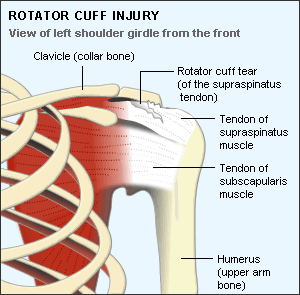
Common Presentation:
Sudden or gradual onset of a dull ache deep inside the shoulder and weakness. Activities with the arm above the head or behind the back most commonly affected.
Overview:
Rotator cuff tears are unfortunately a pretty common cause of left shoulder pain (and a common shoulder complaint and physiotherapy case load we see in our physio clinics)
Our rotator cuff muscles is a group of four muscles that surround the shoulder joint and control its movement and stability.
Rotator cuff tears typically occur gradually over time through wear and tear (typically over the age of 40) or suddenly with an injury (typically younger people with falls or accidents).
The severity of the symptoms will depend on the extent of the tear.
2) Tendonitis
Common Presentation:
Gradual onset of symptoms with underlying ache around the shoulder and sharp pain when moving the arm, particularly above head height.
Patients often report that they can't sleep well or keep waking up from the shoulder pain.
Overview:
Inflammation or degeneration of the muscle tendons can lead to left shoulder pain. The location of pain varies, as it depends on which of the rotator cuff muscle is affected.
Pain tends to be worse with arm movement with minimal pain at rest, and there may be some associated weakness.
Tendonitis is usually caused by repetitive, overhead movements
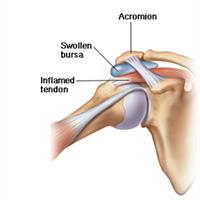
Common Presentation:
Low level ache that typically worsens with arm movements. Pain tends to be very localised (ie specific spot/locations)
Overview:
Bursa are small fluid filled sacs that sit between bone and soft tissue to allow smooth, friction-free movement.
Inflammation from injury or repetitive movements leads to shoulder pain.
Left shoulder pain from bursitis is often accompanied by other problems such as impingement syndrome
Common Presentation:
- Shoulder pain that's diffused, together with shoulder instability with occasional catching/locking sensations.
- Usually develops after an injury but can develop gradually from wear and tear
Overview:
The labrum is a special layer of cartilage that lines the shoulder joint to help improve the stability of the shoulder.
If the shoulder labrum is torn, as well as pain, there is often shoulder instability.
The labrum can be damaged by trauma to the shoulder such as
- a fall or
- from repetitive
overhead movements or
- heavy lifting
A tear at the top of the labrum is known as a Bankart Lesion, and a tear at the bottom is known as a SLAP tear.
The pain is often a generalized and ill-defined ache around the shoulder and upper left arm pain rather than over a specific point
Common Presentation:
- dull pain
- aching pain
- deep pain
which may or may not be localised and may even cause "traveling, radiating" pain that travels up or down eg trigger cervicogenic headache.
There may be a small palpable pea-sized lump within the muscles in and around the shoulder, that "may disappear" with deep tissue release, dry needling or frictional massage.
Overview:
Trigger points are often unsuspected causes of left shoulder pain.
They are small, tight nodules or bands in the fascia that surrounds muscles, commonly referred to as “knots”. They are often hypersensitive to touch and can refer pain around the shoulder and down the arm with or without compression of the trigger point.
They are usually treated by
- deep tissue release massage
- dry needling
- myofascial trigger point release
- friction massage
- acupuncture
- injections
- ultrasound therapy
- radio-frequency Indiba physiotherapy
- stretches
Shoulder Joint Conditions
There are a few conditions affecting the inside of the shoulder joint that can lead to left arm pain:
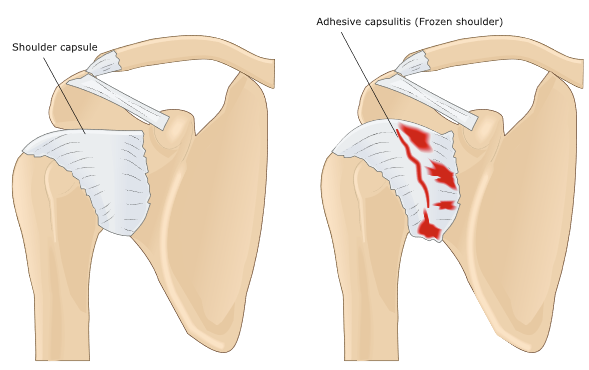
Common Presentation:
Gradual onset progressing through three phases:
- Stage 1 increasing shoulder pain with minimal stiffness
- Stage 2 increasing stiffness, decreasing pain
- Stage 3 stiffness gradually resolves
Overview:
A frozen shoulder can cause left shoulder pain due to joint capsule thickening and tightening.
In most cases symptoms develop gradually with no obvious cause, but some people develop a frozen shoulder after an injury or surgery.
It can take around 18 months to 2 years to fully recover. Typically only affects one shoulder, but that being said, frozen shoulder can recur (ie it can come back) and in some patients, it gradually occurs to the non-frozen shoulder at some point later too.
It is rare to have frozen shoulder in both shoulders at the same time, but it is possible.
2) Shoulder Impingement Syndrome
Common Presentation:
- sharp, painful arc with shoulder movement
- with associated weakness and sleep disturbance
Overview:
Shoulder impingement is a common cause of left arm pain and is a collective term for anything that reduces the space in the shoulder joint causing the soft tissues to get trapped.
It may be due to bone spurs and/or inflammation of the soft tissues in the joint.
Space in the joint is at its least when the arm is at shoulder height so symptoms tend to be worse around that region, with some left arm pain when the arm is low down or right above your head.
Patients often report that their sleep is poor and disturbed as it can be very painful to lie on
the affected side, and just moving or shifting a little can trigger a painful shoulder pain.
Bone Problems
Left shoulder pain can be due to a problem with the bones of the shoulder joint. Possible problems include:
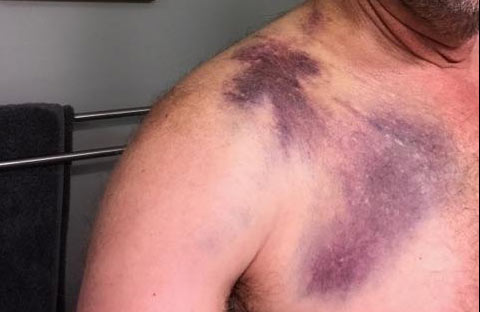
Common Presentation:
- Sudden onset of localized pain following an injury such as a fall
- Usually accompanied with shoulder and clavicular bruising
Overview:
A break in one of the shoulder bones (humerus, scapula or collar bone).
Left arm pain from a fracture is usually associated with a specific injury such as a fall with immediate symptoms.
Pain tends to be localised over the fracture site and there may be an obvious deformity.
If you suspect your left arm pain is due to a broken bone, you should see an orthopedic doctor or our senior physiotherapists immediately.
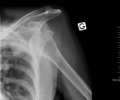
Common Presentation:
- sudden onset of left shoulder pain
- shoulder joint gapping deformity following an injury
Overview:
Our shoulder joint is held together tightly with muscles and ligaments but the joint socket is shallow putting it at risk of dislocation, most commonly forwards (medically termed as "anterior shoulder dislocation".
Usually, it takes a large force to dislocate the shoulder, it doesn’t just “pop out”, unless there are pre-existing problems with stability such as
- multi-directional shoulder instability or
- previous shoulder injury or
- existing unresolved shoulder instability
There typically will be an obvious deformity and usually severe left arm pain.
If you think you have dislocated your shoulder, don’t try to relocate it (put it back in place) yourself - that should be done by a medical professional to minimise damage to the shoulder and surrounding structures.
Common Presentation:
- Gradual onset of left shoulder pain
- often associated with shoulder stiffness
- often associated with shoulder joint grinding (bone-to-bone) sensation
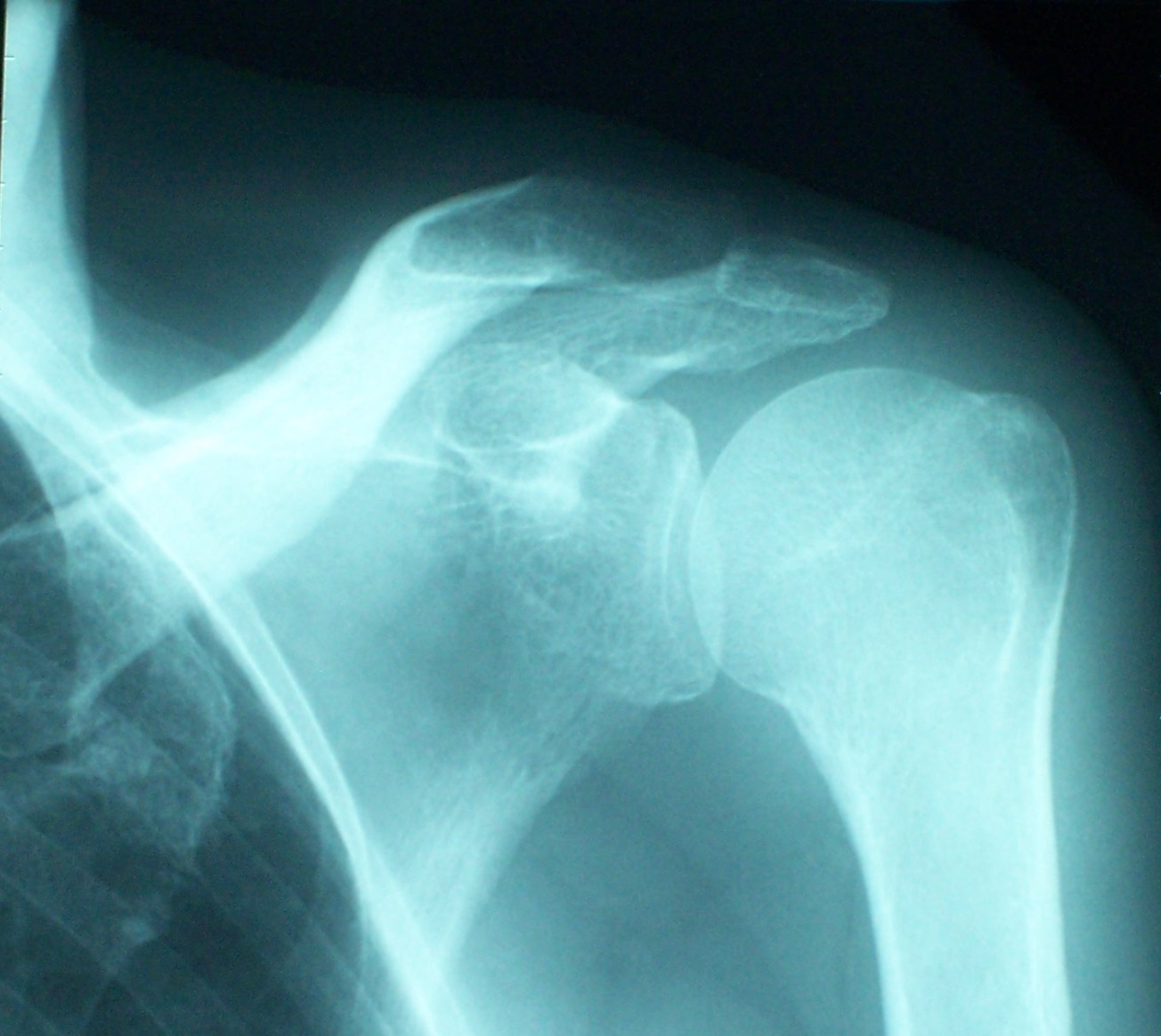
Overview:
Wear and tear (osteoarthritis) or inflammation (rheumatoid arthritis) of the shoulder joint can cause left shoulder pain.
Patients may typically experience shoulder pain, as well as increasing shoulder joint stiffness and grinding/clicking sensations.
Typically, osteoarthritis pain tends to affect just one shoulder, whereas rheumatoid arthritis usually affects both.
Spinal or Nerve Problems
Damage or irritation to the nerves that supply the shoulder and arm can cause left shoulder pain.
There may be a problem in the neck or somewhere along the path of the nerve that causes pinching or irritation of the nerve that leads to or causes pain and/or altered sensations.
1) Neck Problem: e.g. disc bulge, arthritis, trapped nerve
Common Presentation:
- altered sensation (pins and needles/numbness)
- weakness
- left shoulder pain that may radiate down the arm to the elbow, wrist and hand
- in some cases, patients may experience these symptoms in both arms
Overview:
Nerves carry signals to and from the brain and spinal cord to muscles with regards to movement and sensation.
That's why anything that causes any forms of irritation to a nerve, such as pinching or inflammation can and will affect the signal transmission or over sensitise the nerve.
Nerve pain may be felt at the source of the problem e.g. in the neck if there is arthritis or a slipped disc, but in many cases symptoms may be referred down the arm.
Left shoulder pain that travels down the arm, with or without neck pain, is often related, at least in part, to neural problems. Depending on where the nerve is irritated, symptoms may be in one or both arms.
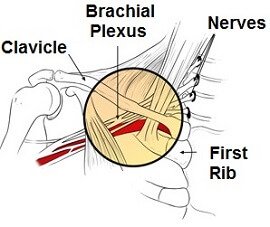
Common Presentation:
- Sudden shoulder pain
- severe shoulder pain
- constant shoulder pain
that often starts at night and may spread down the arm. After a few days shoulder weakness may develop.
Overview:
A problem in the immune system attacks the nerve fibres in the brachial plexus (a bundle of nerves at the root of the neck).
Symptoms develop rapidly and get progressively worse. It is notoriously difficult to diagnose and tends to be one of the less common causes of left shoulder pain
Reference Sources
